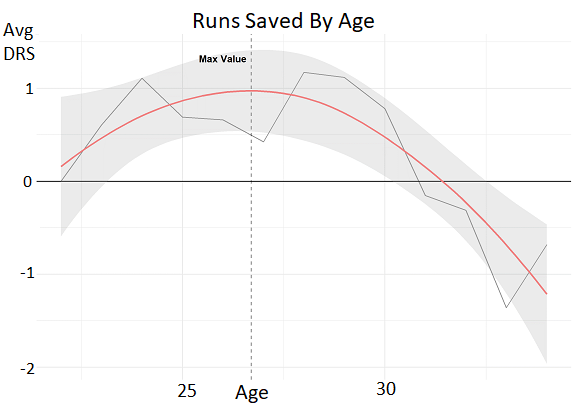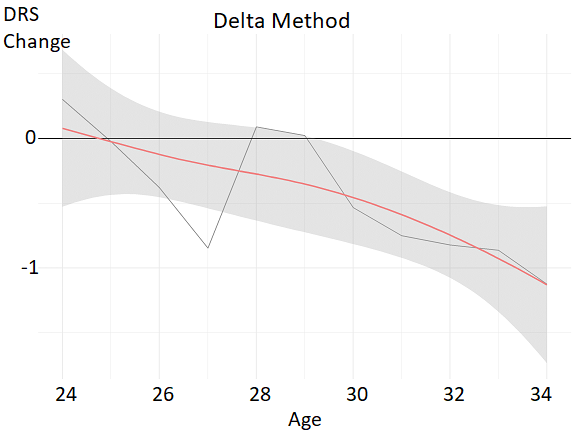The following article was written in April 2019 and is an excerpt from The Fielding Bible – Volume V, on sale now at ACTA Sports.
Executive Summary
It is understood that as a player ages, his performance weakens, but just how does that happen on the defensive end? In looking at the history of Defensive Runs Saved, an aging curve was generated. It showed that a player’s defensive peak is his age 26 season, with a steady decline for the rest of his career, including a more substantial decline beyond his age 30 season.
Introduction
This adds another challenging element to signing free agents, because almost every player will hit free agency past his defensive peak.
How is a player’s defense impacted as he ages?
Some of the signings in the 2018-19 offseason merit that question. With 27-year-old Nolan Arenado, who signed an eight-year contract extension, it seems fair to consider whether he’s hit his defensive peak yet. He finished with 5 Defensive Runs Saved (DRS) in 2018 after back-to-back seasons of saving 20 runs.
With the two 26-year-olds, Manny Machado and Bryce Harper, it’s a question of how much their poor performance in DRS in 2018 may foreshadow some sort of decline for the long term. Machado struggled at shortstop in 2018 and will move back to third base with the Padres after inking an eight-year deal. Harper blamed tired legs and playing out of position in center field for a season in which his defense cost the Nationals 26 runs. He’s signed with the Phillies for the next 13 seasons.
To get a better feel for how much aging impacts a player’s defensive performance, the history of the DRS stat was studied.

Methodology
To start, a player’s total DRS values dating back to 2003 were aggregated by age to produce average values by age group. When looking at these values, you can see that a player’s defensive peak is around his age 26 season, with a steady decline for the rest of his career, including a more substantial decline beyond their age 30 season.
The plot gives a general idea about a player’s expected career trajectory but is ultimately incomplete. Simple averages by age fail to account for survivorship bias in older players, selection bias of younger players who are good enough to make the majors at a young age, and more generally fails to account for how different players develop from year to year.
A few different methods were used to account for this and provide a more complete analysis.
To account for the volatility of defensive performance from year to year, a two-year rolling total, converted to DRS per 1,000 innings is used as opposed to single-season DRS totals. The sample included only players who had played in at least 1,800 fractional innings over the course of the two seasons.
Additionally, since all positions are not created equal, a positional adjustment was used. The goal was to account for players who switched to easier positions as they aged. This also inherently gives extra value to players who excelled in more difficult positions such as center field. The positional adjustments used are shown below:
| Position | Adjustment |
| First Base | 13 |
| Second Base | 32 |
| Third Base | 25 |
| Shortstop | 36 |
| Left Field | 19 |
| Center Field | 29 |
| Right Field | 20 |
Finally, the DRS totals were evaluated using the Delta method. The sample included only players who played in consecutive two-year windows, and their change in DRS between those two windows. As an example, a player who has 4 DRS per 1,000 innings in his age 26 and 27 seasons, and 2 combined DRS per 1,000 between his age 27 and 28 seasons would be evaluated as having -2 DRS, despite both values being positive.

As an example, a typical player who peaked with 5 Runs Saved in their age 25 season could be expected to see that number decrease to 3 Runs Saved by their age 30 season, and to 0 by their age 34 season. There will be outliers in each direction, but the images presented show an overall representation.
Conclusion
When looking at the plot, the pattern in defense becomes clearer. The average player’s defensive performance begins a steady decline following their age 25 season and takes an even sharper decline following their age 30 season.
With defensive performance declining that early, it is extremely rare that a free agent will still be trending upwards defensively. It’s another factor to be considered within the risk of signing players like Arenado, Harper, and Machado long term.


